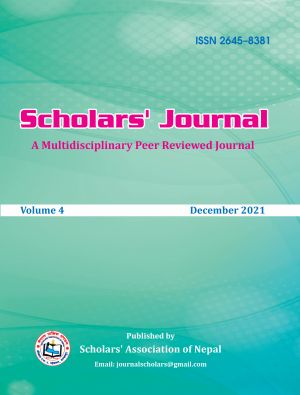‘चिसो एष्ट्रे’ कवितामा ध्वनि सौन्दर्य र ध्वन्यार्थको पहिचान {The identity of sound beauty and semantics in the poem 'Chiso Ashtray'}
DOI:
https://doi.org/10.3126/scholars.v4i1.42657Keywords:
socialism, subalterns, anomalies, Rhetoric, postmodernism, अलङ्कार, उत्तरआधुनिकता, लक्षणविज्ञान, विसङ्गतिबोध, सबाल्टर्न, समाजवादAbstract
प्रस्तुत अध्ययन कवि भूपी शेरचनद्वारा रचित ‘चिसो एष्ट्रे’ गद्य लघु–कविताभित्र प्रयुक्त ध्वनि सौन्दर्यको पहिचान रविश्लेषणमा केन्द्रित छ । एउटै पङ्क्तिको ४५ शब्दमा रचित यस कविताभित्रको त्रिकोणात्मक घटनालाई आनन्दवर्धनकोध्वनि सिद्धान्तका आधारमा केलाउनु नै यस अध्ययनको मूल उद्देश्य रहेको छ । पूर्वीय साहित्य सिद्धान्तमा आधारित भएरयो अध्ययनलाई वाच्यार्थ र व्यङ्ग्यार्थको कोणबाट विश्लेषण गरिएको छ । कवितामा प्रयुक्त भनाइको गाम्भीर्यता र ध्वनिकोसुगठनलाई उक्तिवैचित्यका आधारमा अध्ययनको केन्द्रविन्दु बनाइएको छ । ग्रामीण समाजका निम्नमध्यम वर्गले ठुलोभनिएको सहर काठमाडौँमा आएर जीवन सुधार्ने सपना देख्नु, तिनले अनेकन सङ्घर्ष गरे पनि हन्डर खाइरहनु तथा टुटेकोठुटे लक्ष्य बोकेर घर फर्कनु पर्दाको विसङ्गतिलाई यस अध्ययनमा ध्वनि सौन्दर्यको व्यङ्ग्यार्थ भावका आधारमा केलाइएकोछ । यसमा शब्द सौन्दर्य र अर्थगत आधारलाई विश्लेषण गरिएको छ । यो लेख गुणात्मक अध्ययन विधिमा आधारित छ ।पुस्तकालयीय सन्दर्भ सामग्रीको उपयोगद्वारा सम्पन्न गरिएको यस लेखमा विशेष गरेर ध्वनि सौन्दर्यको पहिचानलाई मूलआधार बनाइएको छ । समग्रतः यस कवितामा बिम्बात्मक भाव, विसङ्गतिबोधको चित्र र सबाल्टर्न वर्गको दीनताभित्रसजिएको ध्वनि सौन्दर्यचेत ध्वनित रहेको पाइएको छ । {The present study focuses on the analysis of the sound beauty used in the prose short poem 'Chiso Ashtre' written by the poet Bhupi Sherchan. The main objective of this study is to examine the triangular phenomenon in this poem composed in 45 words of the same line on the basis of Anandavardhanako dhwani principle. Based on Eastern literary theory, the study is analyzed from the angle of semantics and satire. The seriousness of the utterances used in the poems and the composition of the sounds have been made the focal point of the study on the basis of idioms. The study examines the anomalies of the lower middle class of rural society dreaming of a better life in Kathmandu, eating hunder despite many struggles and returning home with broken goals based on the irony of sound beauty. It analyzes the word beauty and semantic basis. This article is based on a qualitative study method. This article, conducted using library reference materials, focuses on the identification of sound beauty in particular. Overall, this poem is found to have an aesthetic sense, a picture of a sense of anomaly, and an aesthetic sound embedded in the humility of the subaltern class.}
Downloads
Downloads
Published
How to Cite
Issue
Section
License

This work is licensed under a Creative Commons Attribution-NonCommercial 4.0 International License.
Copyright © The Authors

